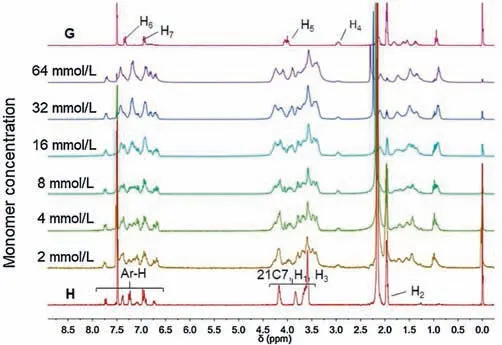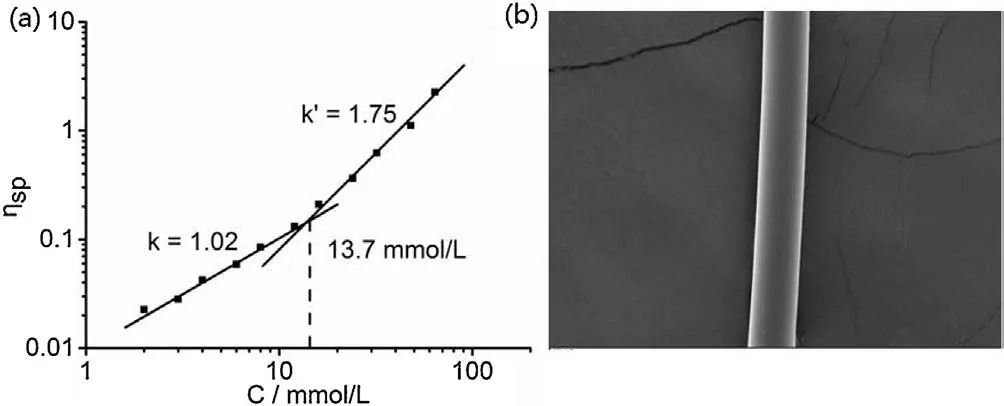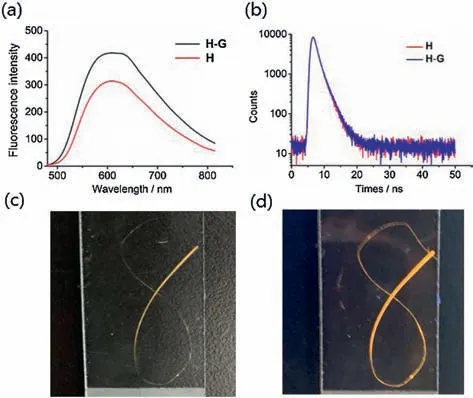Preparation of a fixed-tetraphenylethylene motif bridged ditopic benzo-21-crown-7 and its application for constructing AIE supramolecular polymers
2021-10-14TngxinXioJieWngYongShenChengBoZhengYiLiXioQingSunLeyongWng
Tngxin Xio*,Jie WngYong ShenCheng BoZheng-Yi LiXio-Qing SunLeyong Wng
a School of Petrochemical Engineering, Changzhou University, Changzhou 213164, China
b School of Chemistry and Chemical Engineering, Nanjing University, Nanjing 210023, China
ABSTRACT Benzo-21-crown-7(B21C7)is one of the most important crown ethers,which not only shows excellent physicochemical properties but also exhibits promising binding capability with dialkylammonium salts.In this paper, we designed and synthesized a fixed-tetraphenylethylene (FTPE) motif bridged ditopic benzo-21-crown-7 molecule (H).The fixed tetraphenylethylene motif endows H with aggregation induced emission(AIE)property.In the presence of a ditopic dialkylammonium salt guest molecule(G),a fluorescent supramolecular polymer with golden luminescent property could be fabricated.This B21C7-based host-guest supramolecular polymer with golden fluorescence may have potential application in dynamic luminescent materials.
Keywords:Benzo-21-crown-7 Host-guest interaction Supramolecular polymer Fluorescent materials AIE
Supramolecular polymers, as a result of the combination of conventional polymer science and supramolecular chemistry, are promising materials that generally exhibit dynamic properties[1-5].In contrast to covalent bonded polymers, repeating units of supramolecular polymers are integrated together by non-covalent interactions, such as multiple hydrogen bonding [6-9], metalligand coordination [10-13], host-guest interaction [14-26], π-π stacking [27-30], or a combination of these non-covalent bonds[31-34].In recent years, the focus of studying supramolecular polymers have gradually changed from construction strategy to the development of new functionality of supramolecular polymers,which is more important for their real applications.For example,the development of fluorescent supramolecular polymers has drawn much attention due to their potential application in luminescent materials, chemical sensors, and optoelectronics[35-41].
Since its first report [42], B21C7 has shown promising properties/applications in various areas including lower critical solution temperature behavior(LCST)[43-45],adhesive materials[46,47], bulk supramolecular materials [48].B21C7 is a specific member in crown ether family that can accommodate dialkylammonium salts tightly, leading to excellent host-guest properties.Fixed-tetraphenylethylene (FTPE) is an analogue of tetraphenylethylene (TPE), from which two of its benzene groups are fixed by a covalent bond.Compared with TPE, FTPE is less studied but is also an outstanding AIE motif[49-51].To the best of our knowledge,the integration of B21C7 unit and FTPE motif to one molecule has not been reported so far.
Based on our experience on B21C7 [52,53], we designed and synthesized a new host molecule H in this work, which contains both B21C7 units and FTPE motif(Fig.1).The FTPE motif endows H with the property of AIE, while B21C7 unit renders compound H with the capability to bind dialkylammonium salt.Upon the addition of compound G, a ditopic dialkylammonium salt guest molecule, a novel AA/BB type supramolecular polymer could be formed by macrocycle-based host-guest interaction.Moreover,the supramolecular polymer could be assembled into macroscopic fibers with golden fluorescence from concentrated solution.This crown ether-based supramolecular polymer with beautiful golden fluorescence in solid state may have potential application in dynamic luminescent materials.

Fig.1.Schematic illustration of the AIE supramolecular polymer material constructed from H and G.
The synthesis of monomer H and G are straightforward.Compound H was synthesized from B21C7-based derivative A[38] and FTPE-based derivative B (Scheme 1).As shown in Scheme 1, starting from 9-fluorenone, compound 4 was prepared and further converted to FTPE precursor 5 in toluene solution by Suzuki reaction.Demethylation of compound 5 with boron tribromide in dichloromethane (DCM) yields compound 6 [49].Subsequent reaction with N-(3-bromopropyl)phthalimide afforded compound 7, which could be further hydrolyzed to produce amino derivative B.Compound G was synthesized according to literature report [54].The compounds that have not been reported previously are fully characterized by1H NMR,13C NMR and HR-MS (Figs.S2-S10 in Supporting information).

Scheme 1.Synthetic route of compound H.
To examine whether the FTPE motif bridged ditopic B21C7 are still AIE active, the emission spectra of H in mixed CHCl3/hexane solutions were tested.As shown in Fig.2, compound H exhibits remarkable AIE property.There is no emission when H was dissolved in pure CHCl3(a good solvent for H).When the hexane(a poor solvent for H) content of a solution of H was increased gradually to 80%,an obvious emission spectrum was observed.As the hexane content continues to increase to 90%,the fluorescence intensity of H also shows a dramatic continuous increase.The emission wavelength of H was kept constant at 560 nm in the mixed solvent when excited at 365 nm.

Fig.2.Fluorescence emission spectra of H versus hexane fraction in CHCl3/hexane mixtures (λex = 365 nm, [H]=5×10-5 mol/L).
The formation of supramolecular polymers from H and G was first studied by concentration-dependent1H NMR, which was measured in CDCl3/CD3CN(1:1,v/v)at concentrations in the range of 2-64 mmol/L (Fig.3).The concentration-dependent1H NMR spectra were complicated due to the slow-exchange complexation of the B21C7 and the dialkylammonium salt units on the NMR timescale.Although the spectra are complicated, the splitting of peaks is relatively clear in the low concentration range (2-8 mmol/L),indicating that cyclic oligomers are predominant species at low concentration.Upon increasing the monomer concentration, most of the peaks became broad,providing evidence for the formation of high-molecular-weight assemblies driven by hostguest interactions.

Fig.3.1H NMR spectra(300 MHz,CDCl3/CD3CN=1/1,v/v,298 K)of individual H and G, and mixtures of them at different monomer concentrations ([H]/[G]=1/1).
In order to further investigate the supramolecular polymers driven by host-guest self-assembly,viscosity measurements were carried out in mixed CHCl3/CH3CN solvents (1:1, v/v) by using a micro-Ubbelohde viscometer.A double logarithmic curve of specific viscosity against monomer concentration was shown in Fig.4a.A slope value of 1.02 was obtained in the low concentration range, which is the characteristic of cyclic oligomers with unchanged size.When the monomer concentration reaches 13.7 mmol/L,a new curve with a steeper slope 1.75 was obtained,indicating that the transformation of cyclic oligomers to supramolecular polymers are occurred.The concentration range for such transformation was basically consistent with concentrationdependent1H NMR.The formation of supramolecular polymers was further evidenced by scanning electronic microscopy (SEM)(Fig.4b).Rod-like fibers with a diameter of 9 μm can be pulled out from a very concentrated solution of H and G (molar ratio of H/G=1/1).This kind of fibers can be only made from entanglements of large aggregates, such as supramolecular polymers.On the contrary,no fiber can be drawn from the concentrated solution of individual H or individual G.

Fig.4.(a)Specific viscosity of H-G complex versus the monomer concentration in CDCl3/CD3CN (1:1, v/v) solutions (298 K).(b) SEM image of a rod-like fiber constructed from H and G.
The photophysical properties of H-G supramolecular polymers were further studied by solid-state fluorescence.As shown in Fig.5a, the emission wavelength of H in solid state is bathochromically shifted from 560 nm in solution to 610 nm.The H-G supramolecular polymer in solid state showed stronger emission intensity but the same maximum emission wavelength with H,suggesting that the formation of supramolecular polymer does not weaken but enhance the AIE behavior of H.This might be due to the incorporation of the guest affected the packing arrangement of the fluorophores,resulting in enhanced luminescent properties.From the fluorescence decay profiles (Fig.5b and Fig.S1 in Supporting information),we can see that the fluorescence lifetime of H-G(τ=1.75 ns) is slightly higher than H (τ = 1.59 ns), further indicating that the supramolecular polymer maintains the fidelity of AIE from host molecules.Finally, in order to illustrate the fluorescent properties of the supramolecular polymer more intuitively, a figure-of-eight supramolecular polymer fiber was prepared.The pictures under visible light and ultraviolet(UV)light are shown in Figs.5c and d.It can be seen that under UV lamp, the fiber emits strong golden yellow fluorescence.This strong luminescence behavior can be maintained even after several weeks, suggesting that the supramolecular polymer prepared in this work has potential applications as dynamic luminescent material.

Fig.5.(a) Fluorescence spectra of H and H-G in solid state, λex = 365 nm.(b)Fluorescence decay profiles of H and H-G in solid state.(c) Optical and (d)fluorescent images of a figure-of-eight fiber.
In summary, we have successfully prepared a golden luminescent supramolecular polymer from a FTPE motif bridged ditopic B21C7 host molecule and a ditopic dialkylammonium salt guest molecule.The host-guest polymerization process was characterized by a combination of techniques including concentrationdependent1H NMR, SEM, and viscosity measurements.Fluorescent properties of the supramolecular polymer in solid state are also investigated, which indicates that the supramolecular polymer well inherits the AIE activity of the host and emits beautiful golden yellow fluorescence.The AIE supramolecular polymer described in this study may have potential applications in the area of dynamic luminescent materials.
Declaration of competing interest
The authors report no declarations of interest.
Acknowledgment
We gratefully thank the financial support from the National Natural Science Foundation of China (No.21702020).
Appendix A.Supplementary data
Supplementary material related to this article can be found,in the online version, at doi:https://doi.org/10.1016/j.cclet.2020.10.037.
杂志排行
Chinese Chemical Letters的其它文章
- D-A-D structured selenadiazolesbenzothiadiazole-based near-infrared dye for enhanced photoacoustic imaging and photothermal cancer therapy
- Synthesis and biological evaluation of a lipopeptide-based methamphetamine vaccine
- Nucleic acids induced peptide-based AIE nanoparticles for fast cell imaging
- Titanate nanofibers reduce Kruppel-like factor 2(KLF2)-eNOS pathway in endothelial monolayer: A transcriptomic study
- Drug-induced hierarchical self-assembly of poly(amino acid) for efficient intracellular drug delivery
- Co-delivery of anticancer drugs and cell penetrating peptides for improved cancer therapy
